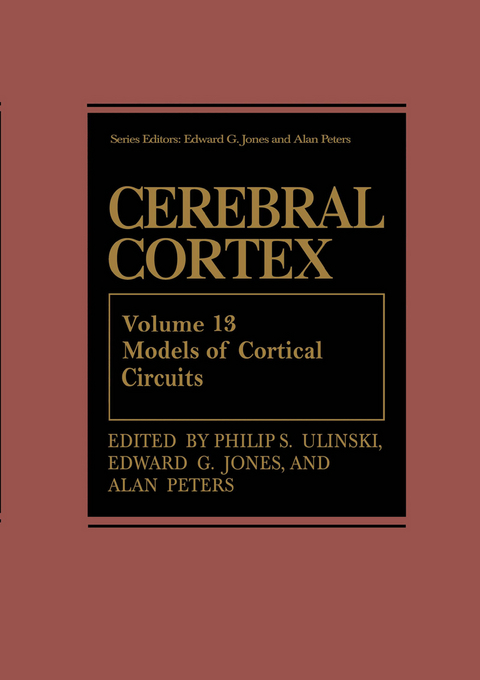
Cerebral Cortex
Kluwer Academic/Plenum Publishers (Verlag)
978-0-306-45727-2 (ISBN)
Thisisthefirstvolumeinthe CerelJral Cortexseriesdevotedtomathematicalmodels ofthecortex. Itwasmotivatedbytherealizationthatcomputationalmodelsof individualneuronsandensemblesofneuronsareincreasinglyusedinresearchon corticalorganizationandfunction. Thisis,inpart,becauseofthenowubiquitous presenceofpowerfulandaffordablecomputers. Suitablemachineswereformerly rareinresearchlaboratoriesandrequiredsubstantialprogrammingexpertisetobe usedinconstructingandusingneuronalmodels. However,computersarenow routinelyusedinallareasofneurobiologyandanumberofsoftwarepackagesallow scientistswithminimalcomputerscienceandmathematicalbackgroundstocon- structseriousneuronalmodels. Asecondfactorleadingtotheproliferationof modelingstudiesisthedevelopmentoftechnologiesthatallowthekindsofdata collectionneededtodeveloprealisticmodelsofcorticalneurons. Characterization ofthekineticsofvoltage-andligand-gatedchannelsandreceptorshadbeenlim- itedtorelativelylargeneurons. However,therapiddevelopmentofsliceprepara- tions,patch-clampmethods,andimagingmethodsbasedonvoltage-sensitivedyes andintracellularcalciumindicatorshasresultedinasignificantdatabaseonthe biophysicalfeaturesofcorticalneurons.
Thescopeofmodelingapproachestocorticalneuronsandfunctionsiswide anditseemednecessarytolimitthepurviewofthevolume. Thefocusisonattempts tounderstandthepropertiesofindividualcorticalneuronsandneuronalcircuitry throughmodelsthatincorporatesignificantfeaturesofcellularmorphologyand physiology. Noattemptwasmadetoincludemodelingapproachestounderstanding corticaldevelopmentandplasticity. Thus,workdealingwiththedevelopmentof oculardominancecolumnsandtheorientationselectivityofneuronsinvisualcortex isnotconsidered. Similarly,modelsdealingwiththecellularmechanismsunderlying long-termplasticityandwithapproachestolearningandmemorybasedonmodifica- tionofHebbiansynapsesarenotconsidered. Relativelyabstractattemptstounder- standhigherlevelandcognitiveprocessesbasedonneuralnetsrepresentasecond, majorareaofworkthatisnottreated. Modelsofcognitiveprocessesbasedon dynamicalsystemsmethodsinwhichnoattemptismadetoincludethebiophysical featuresofindividualneuronsarealsonotconsidered. vii viii Thetenmajorchaptersfallintothreegroups. Thefirstgroupdealswith compartmentalmodelsofindividualcorticalneurons.
LyleBorg-Grahamprovides PREFACE anintroductiontothemethodsinvolvedinconstructingcompartmentalmodels andthenreviewstheexistingmodelsofhippocampalpyramidalcells. Becauseof theeffectivenessofhippocampalslicepreparations,theseneuronshavewell-ehar- acterizedbiophysicalproperties. Thischapterillustrateshowcompartmentalmod- elscanbeusedtosynthesizeexperimentaldataandprovideanintegrativeviewof thepropertiesofindividualneurons. PaulRhodescontinuesthethemebyfocusing ontheroleofvoltage-gatedchannelslocatedonthedendritesofcorticalneurons. Thisisanareainwhichtechnologicaladvancesinthevisualizationofneuronsin slicepreparationsbasedoninfraredmicroscopyhavegreatlyexpandedtheinfor- mationavailableondendriticfunctioninjustafewyears. Thechapterbothreviews theexperimentaldataonactivedendriticconductancesandemphasizestheirpo- tentialfunctionalroles. Thesecondgroupofchaptersdealwiththegenerationofreceptivefield propertiesofneuronswithinvisualcortex. Theyaddressissuesstemmingfromthe originalattempttounderstandhowthereceptivefieldpropertiesofneuronsincat andmonkeyprimaryvisualcortexaregeneratedbyinteractionsbetweengenicu- lateafferentsandcorticalneurons.
ThechapterbyFlorentinWorgotterevaluates modelsthathavebeenusedtoanalyzethegenerationofreceptivefieldproperties. RodneyDouglasandhiscolleaguesaddressaspecificsetofissuesdealingwiththe roleofintracorticalexcitationmediatedbypyramidalcellcollaterals. Animportant featureofthischapterisitsrelationtoattempttoconstructfabricatedcircuitsthat duplicatethefunctionsofcorticalcircuits. ThechapterbyPhilipUlinskifocuseson thegenerationofmotion-selectivepropertiesincorticalneurons. Itseekstoidenti- tycellularmechanismsusedbyneuronsthatrespondpreferentiallytovisualstimuli movingwithparticularspeedsordirections. MatteoCarandiniandhiscolleagues discussthefeatureofcorticalneurons,knownasgaincontrol,thatallowsneurons torespondeffectivelytovisualstimulibypoolinginformationacrosspopulationsof corticalneurons. ThechapterbyHughWilsondealswiththereceptivefieldproper- tiesofextrastriateareasandintroducesnewworkanalyzingface-selectiveneurons. Thefinalsetofchaptersconsidermodelsofensemblesofthalamicandcortical neurons. ThechapterbyWilliamLyttonandElizabethThomasusesthetheoryof dynamicalsystemstoanalyzethetemporalrelationshipsbetweenthalamicand corticalneurons.
Animportantfeatureoftheinteractionbetweenthalamusand cortexisthepresenceofoscillationsthatdependinpartuponthevoltage-gated conductancespresentonindividualneuronsandinpartonthestructureofthe overallnetwork. PaulBushcontinuesthisemphasisonoscillationsbydiscussinga modelthatdealswiththegenerationofsynchronizedoscillationsinvisualcortex. Oscillationsofthiskindhaveattractedsubstantialattentioninrecentyearsbecause oftheirpotentialroleincognitiveprocesses. Thelastchapter,byMichaelHasselmo andChristianeLinster,reviewstheirworkonmodelingpiriformcortex,emphasiz- ingtheroleofcholinergicmechanismsinmodulatingtheactivityofcorticalneu- rons. Anattempthasbeenmadethroughouttomakethevolumeaccessibleto readerswithminimalmathematicalbackgrounds. Thevolumethusbeginswitha shorthistoryofmodelsofcorticalneuronsandcircuitrythatintroducestheprinci- palmodelingstyles. ThechaptersbyWorgotterandUlinskicontainmoreextensive ix introductionstosomeofthemodelingmethodsthathavebeenusedtostudyvisual cortex,andthemathematicallychallengedreaderwillfindthatthechapterby PREFACE LyttonandThomascontainsareadableintroductiontotheuseofdynamical systemstheoryinneurobiology. PhilipS. Ulinski EdwardG.
Jones Chicago and Davis Contents Chapter 1 ModelingCorticalCircuitry:AHistoryandProspectus PhilipS. Ulinski 1. Introduction "...1 2. LorentedeNothroughDynamicalSystemsModels...2 2. 1. LorentedeNo...2 2. 2. CellAssembliesandNeuralNets...3 2. 3. DynamicSystemsModels...8 3. HodgkinandHuxleythroughNetworkModels...11 3. 1. HodgkinandHuxley...11 3. 2. WilfridRall...11 3. 3. SoftwarePackages...13 3. 4. RealisticModelsofCorticalNetworks...14 4. Prospectus...14 5. References...15 Chapter 2 InterpretationsofDataandMechanismsforHippocampalPyramidal CellModels LyleJ Borg-Graham 1. Introduction...19 1. 1. NeuronModelEvolution-followingElectrophysiology...19 1. 2. NeuronModelEvaluation-followingtheParameters...21 1. 3. WhyHippocampus? 21 1. 4. OrganizationofThisChapter...22 xi xii 2. TheDatabaseforSingle-NeuronModels...23 2. 1. VoltageClampversusCurrentClamp...23 CONTENTS 2. 2. Single-ChannelversusMacroscopicCurrents...24 2. 3. TypeofPreparation...24 2. 4. KineticandPharmacologicalDissection...25 2. 5. TemperatureDependence...26 2. 6. AgeDependence...27 2. 7. HippocampalSubfieldDependence...27 2. 8. DifferencesinFiringPropertiesbetweenSharpversusPatch Recordings...28 2. 9. TheMeasuredVoltage...
1 Modeling Cortical Circuitry: A History and Prospectus.- 1. Introduction.- 2. Lorente de Nó through Dynamical Systems Models.- 3. Hodgkin and Huxley through Network Models.- 4. Prospectus.- 5. References.- 2 Interpretations of Data and Mechanisms for Hippocampal Pyramidal Cell Models.- 1. Introduction.- 2. The Database for Single-Neuron Models.- 3. Strategies for Single-Neuron Models.- 4. Anatomy and the Model: Data and Methods.- 5. The Linear Model: Data and Methods.- 6. Phenomenological Templates.- 7. Review of Hippocampal Models.- 8. Channel Models.- 9. Ionic Concentration Dynamics.- 10. Nonsynaptic Channels of Hippocampal Pyramidal Cells.- 11. HPC Sodium Channels.- 12. HPC Calcium Channels.- 13. HPC Potassium Channels.- 14. Nonspecific Cation and Chloride Currents.- 15. Simulations of HPC Properties with the Working Model.- 16. References.- 3 Functional Implications of Active Currents in the Dendrites of Pyramidal Neurons.- 1. Introduction.- 2. Historical Perspective.- 3. Amplification of Synaptic Inputs.- 4. Compartment Model Simulations of Amplification.- 5. Effects of Dendritic Active Currents on EPSP Shape.- 6. The Effect of Dendritic Active Currents in Shaping the Intrinsic Firing Properties of Pyramidal Cells.- 7. Effects of Potassium Currents.- 8. Linking Firing of the Soma to Depolarization at Distal Synapses and the Implementation of Hebb’s Hypothesis.- 9. Apologies.- 10. Concluding Observations.- 11. References.- 4 Comparing Different Modeling Approaches of Visual Cortical Cell Characteristics.- 1. Introduction.- 2. Foundations.- 3. Models of Cortical Orientation Specificity.- 4. Concluding Remarks.- 5. Appendix.- 6. References.- 5 The Role of Recurrent Excitation in Neocortical Circuits.- 1. Introduction.- 2. Wiring Neocortical Circuits.- 3. CanonicalMicrocircuits.- 4. Units of Construction of the Basic Cortical Circuit.- 5. The Neuronal Components of Layer 4.- 6. Computation of Orientation.- 7. Noise and Restoration.- 8. References.- 6 Neural Mechanisms Underlying the Analysis of Moving Visual Stimuli.- 1. Introduction.- 2. A Primer of Basic Concepts.- 3. Neural Mechanisms: Mammals.- 4. Neural Mechanisms: Turtles.- 5. Conclusions and Future Directions.- 6. References.- 7 Linearity and Gain Control in VI Simple Cells.- 1. Introduction.- 2. The Linear Model of Simple Cells.- 3. Some Linear Properties of Simple Cells.- 4. Biophysics of the Linear Model.- 5. Some Nonlinear Properties of Simple Cells.- 6. The Normalization Model of Simple Cells.- 7. Testing the Normalization Model.- 8. Biophysical Plausibility of the Normalization Model.- 9. Conclusions.- 10. References.- 8 Non-Fourier Cortical Processes in Texture, Form, and Motion Perception.- 1. Introduction.- 2. Analysis of Texture Boundaries by Non-Fourier Mechanisms.- 3. Area V4 Neurons and Form Vision.- 4. Two-Dimensional Motion.- 5. Discussion.- 6. References.- 9 Modeling Thalamocortical Oscillations.- 1. Slow Thalamic Rhythms.- 2. Thalamus as Magnet for Modeling—Dynamics and Neural Systems.- 3. Early Modeling Predicted a Role for Inhibitory Phasing.- 4. Modeling the T Channel.- 5. Modeling the Low-Threshold Spike.- 6. The Basic Two-Neuron Network.- 7. The Search for Origins: Whence Spindling?.- 8. Synchrony and Spread of Network Activity.- 9. Summary and Conclusions.- 10. References.- 10 Realistic Network Models of Synchronized Oscillations in Visual Cortex.- 1. Introduction.- 2. Model Structure.- 3. Model Results.- 4. Conclusion.- 5. References.- 11 Modeling the Piriform Cortex.- 1. Introduction.- 2. Summary of Data Being Modeled.- 3. Modeling ofPhysiological Data.- 4. Modeling of Functional Hypotheses.- 5. Summary and Future Directions.- 6. References.
| Reihe/Serie | Cerebral Cortex ; 13 |
|---|---|
| Zusatzinfo | XXI, 573 p. |
| Verlagsort | New York |
| Sprache | englisch |
| Maße | 178 x 254 mm |
| Themenwelt | Medizinische Fachgebiete ► Chirurgie ► Herz- / Thorax- / Gefäßchirurgie |
| Studium ► 1. Studienabschnitt (Vorklinik) ► Anatomie / Neuroanatomie | |
| Naturwissenschaften ► Biologie ► Humanbiologie | |
| Naturwissenschaften ► Biologie ► Zoologie | |
| ISBN-10 | 0-306-45727-X / 030645727X |
| ISBN-13 | 978-0-306-45727-2 / 9780306457272 |
| Zustand | Neuware |
| Haben Sie eine Frage zum Produkt? |
aus dem Bereich


